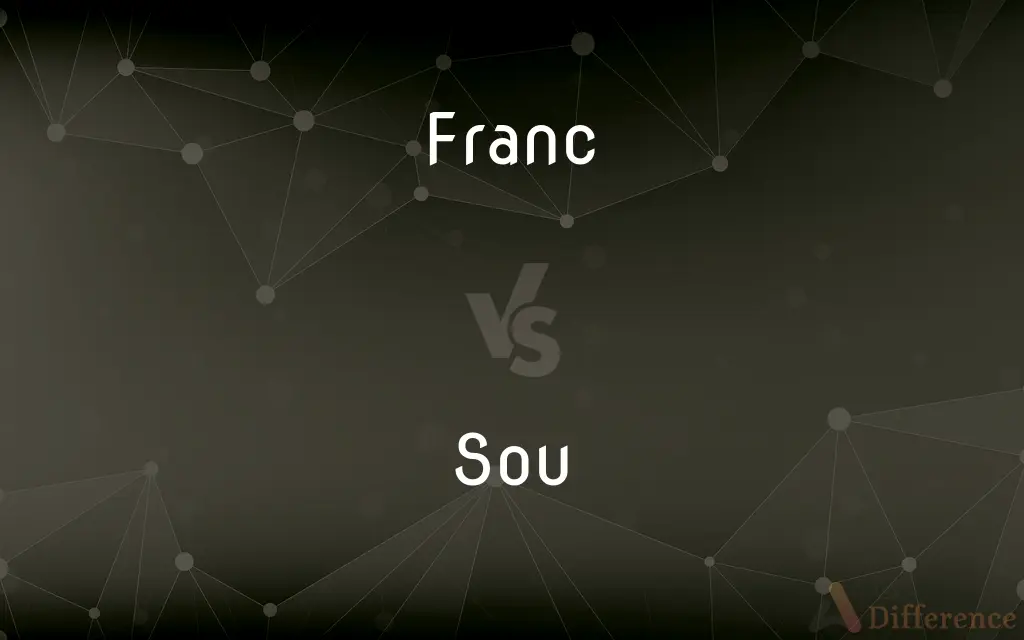Franc vs. Sou — What's the Difference?
Edited by Tayyaba Rehman — By Maham Liaqat — Updated on April 8, 2024
The franc is a currency formerly used in France and several other countries, associated with larger economic transactions, while the sou, historically a smaller denomination of French currency, symbolizes minor expenses.

Difference Between Franc and Sou
Table of Contents
ADVERTISEMENT
Key Differences
The franc was the official currency of France until the introduction of the euro in 2002 and has been adopted by various countries, often symbolizing national economic stability. On the other hand, the sou was a minor coin within the French franc system, representing a fraction of the franc's value, used for everyday small transactions.
While the franc played a significant role in international finance, being a major currency in global markets, the sou's importance was primarily within the domestic economy, used for local purchases and small-scale transactions. The franc's value and stability made it a key player in international trade and investment, whereas the sou facilitated day-to-day commerce and savings for the common people.
In historical contexts, the franc is often mentioned in discussions about national economies, inflation rates, and fiscal policies. Meanwhile, the sou is frequently referenced in literature and historical documents, highlighting its role in society's daily life and culture, embodying the concept of modesty in financial dealings.
Collectors and historians might seek francs for their historical and monetary value, reflecting significant periods in a country's economic history. In contrast, sous are collected for their cultural significance, offering insights into the everyday life and economic conditions of the past.
The transition from the franc (and its subunits like the sou) to the euro marked a significant shift in France's economic identity, reflecting broader European integration. This change underscores the evolution from national currencies with historical roots to a unified currency aimed at economic unity and stability across Europe.
ADVERTISEMENT
Comparison Chart
Status
Former currency unit in France and other countries
Minor denomination within the franc system
Symbolic Value
Economic stability and international finance
Everyday transactions and modest savings
Usage
Large transactions and international trade
Small-scale domestic purchases
Historical Context
Discussed in terms of national economies and policies
Referenced for its cultural significance in daily life
Collectible Interest
Valued by collectors for monetary history
Sought for insights into societal conditions
Compare with Definitions
Franc
Known for its role in international finance.
The Swiss Franc is still considered a stable currency in global markets.
Sou
A small denomination of currency in old French monetary system.
She found an ancient sou in the attic among her grandfather's belongings.
Franc
Replaced by the euro in France in 2002.
France transitioned from the franc to the euro as its official currency.
Sou
Sought for its cultural significance by collectors.
The museum displayed sous to illustrate the economic life of past eras.
Franc
Symbolizes national economic stability.
The franc maintained its value during economic fluctuations.
Sou
Symbolizes the economic conditions of the common people.
The sou was essential for daily purchases in rural France.
Franc
A currency unit formerly used in France and other countries.
The painting was sold for 5,000 francs at the auction.
Sou
Used for minor everyday transactions.
A loaf of bread cost a few sous in the early 20th century.
Franc
Collected for its historical value.
He added an old French franc to his collection of European currencies.
Sou
Represents modesty in financial dealings.
Saving a few sous each day helped him buy a new book.
Franc
The franc is any of various units of currency. One franc is typically divided into 100 centimes.
Sou
One of several coins formerly used in France, worth a small amount.
Franc
See Table at currency.
Sou
(historical) An old French copper coin equal to one twentieth of a livre or twelve deniers; one sou is to the livre as one shilling is to the pound.
Franc
The primary unit of currency in Belgium, France, Luxembourg, and Monaco before the adoption of the euro.
Sou
Cent; pocket money.
Franc
A former unit of currency of France, Belgium and Luxembourg, replaced by the euro.
Sou
(dated) A thing of the smallest value; a whit; a jot.
I do not care a sou for your excuses.
Franc
Any of several units of currency, some of which are multi-national (West African CFA Franc (XOF), Central African CFA Franc (XAF), the Swiss franc (CHF)) while others are national currencies.
Sou
An old French copper coin, equivalent in value to, and now displaced by, the five-centime piece (
Franc
A silver coin of France, and since 1795 the unit of the French monetary system. It has been adopted by Belgium and Swizerland. In 1913 it was equivalent to about nineteen cents American, or ten pence British, and is divided into 100 centimes.
Sou
A former French coin of low denomination; often used of any small amount of money;
He hasn't a sou to his name
Franc
The basic monetary unit in many countries; equal to 100 centimes
Common Curiosities
Are francs still in use today?
Francs have been replaced by the euro in France and many other countries, though some nations still use currencies named "franc."
What does the sou represent in historical contexts?
The sou represents everyday financial dealings and the modest economic conditions of the common people.
Can you still find sou coins today?
Sou coins are no longer in circulation but can be found as collectibles or historical artifacts.
How did the sou fit into the French monetary system?
The sou was a minor coin within the franc system, used for small-scale transactions.
What is the historical significance of the franc?
The franc symbolizes periods of economic stability and national identity in the countries that used it.
Why is the franc considered important in international finance?
The franc was considered a stable and reliable currency, influencing global markets and trade.
How did the transition to the euro affect the franc's value?
The transition to the euro fixed the franc's value at a set conversion rate, ending its fluctuation in the market.
What was the main purpose of the franc in France?
The franc served as the primary currency, facilitating large transactions and international trade.
What happened to the franc after the euro was introduced?
After the euro's introduction, the franc ceased to be legal tender and was phased out of circulation.
How did people use sous in their daily lives?
People used sous for daily purchases, such as food and small goods, reflecting their value in everyday commerce.
Why do collectors seek sous?
Collectors seek sous for their cultural significance, providing insights into the socioeconomic conditions of past societies.
Did the sou have any influence outside of France?
While the sou was primarily a French denomination, its concept influenced minor coinages in other franc-using countries.
What role did the franc play in French history?
The franc played a crucial role in shaping France's economic policy, inflation control, and international trade relations.
How are sous and francs remembered in French culture?
They are remembered as symbols of France's economic history, with the sou representing the common people's daily struggles and the franc symbolizing national economic prowess.
What is the collectible value of francs compared to sous?
Francs are often valued for their historical monetary significance, while sous are sought after for their insight into daily life and culture.
Share Your Discovery

Previous Comparison
Hod vs. Mod
Next Comparison
Significant vs. ImpactAuthor Spotlight
Written by
Maham LiaqatEdited by
Tayyaba RehmanTayyaba Rehman is a distinguished writer, currently serving as a primary contributor to askdifference.com. As a researcher in semantics and etymology, Tayyaba's passion for the complexity of languages and their distinctions has found a perfect home on the platform. Tayyaba delves into the intricacies of language, distinguishing between commonly confused words and phrases, thereby providing clarity for readers worldwide.















































